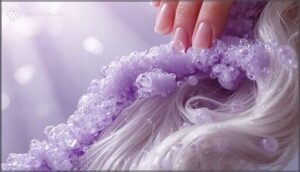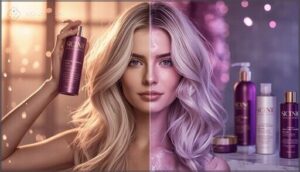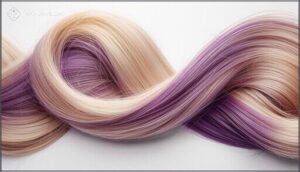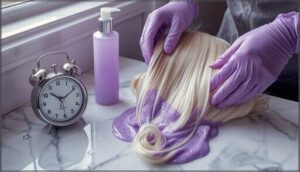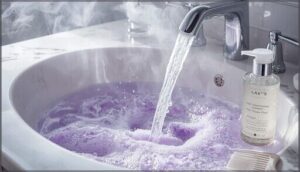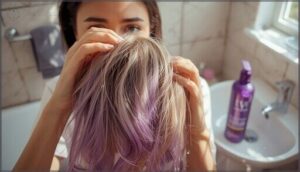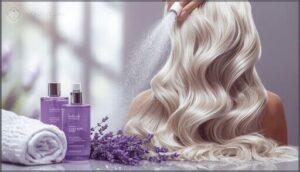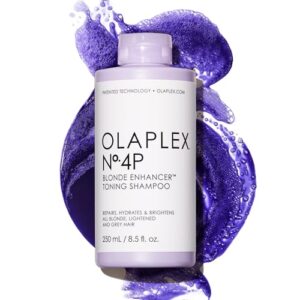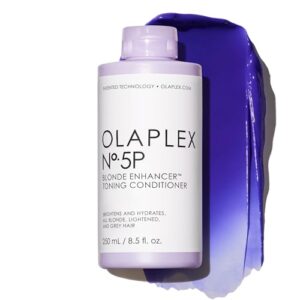This site is supported by our readers. We may earn a commission, at no cost to you, if you purchase through links.
You’ve mastered the art of bleaching your hair to that perfect cool blonde—only to watch it morph into brassy yellow within weeks. The culprit? Environmental factors, mineral deposits, and the natural oxidation process that plagues every lightened strand.
Purple shampoo promises salvation, but applying it to dry hair amplifies both its power and its risks. Leave it on too long, and you’ll sport an unwanted lavender hue; rinse too quickly, and those yellow tones laugh in your face. The difference between stunning silver and regrettable violet comes down to precise timing, and that calculation shifts dramatically when you skip the water.
Most colorists recommend 5-10 minutes for dry application, but your hair’s porosity, damage level, and the shampoo’s pigment concentration can shorten or lengthen that window considerably.
Table Of Contents
- How Purple Shampoo Neutralizes Brassiness
- Should You Apply Purple Shampoo to Dry Hair?
- Benefits of Using Purple Shampoo on Dry Hair
- Risks of Leaving Purple Shampoo on Dry Hair
- Factors Affecting Leave-in Time on Dry Hair
- Recommended Leave-in Time for Dry Hair
- Step-by-Step Guide to Applying on Dry Hair
- What to Do if Hair Turns Purple
- Best Practices for Healthy Toning
- Top 5 Purple Shampoos for Dry Hair Application
- Frequently Asked Questions (FAQs)
- Conclusion
How Purple Shampoo Neutralizes Brassiness
Before you start applying purple shampoo to dry hair, you need to understand how it actually works. The neutralizing process relies on basic color theory, but there’s more happening beneath the surface of your hair shaft than you might think.
Let’s break down the science, the users who benefit most, and what’s causing those unwanted warm tones in the first place.
The Science Behind Purple Pigments
Purple shampoo’s power lies in color theory: violet pigments like Acid Violet 43 absorb yellow-green light at 540–580 nm, canceling brassy tones on contact. These direct dyes bind electrostatically to keratin—especially on porous, bleached hair—without penetrating deep into the cortex.
Purple shampoo neutralizes brass because violet pigments absorb yellow-green light and bind to damaged keratin without penetrating the hair cortex
You’re getting targeted toning effects because damaged cuticles create more binding sites, letting purple pigment neutralize yellow at incredibly low concentrations while preserving your hair’s lightness.
Understanding the color theory basics is essential for effective use of purple shampoo.
Why Blondes and Light Brunettes Use It
Blondes and light brunettes reach for purple shampoo because it’s the fastest route to reclaiming cool, ash-toned color between salon visits. Your blonde hair—whether natural, highlighted, or balayaged—shows yellowing from UV rays, hard water minerals, and heat styling faster than darker shades.
That’s where toning benefits kick in: purple pigment delivers instant color correction and hair restoration, keeping your blonde care routine simple while extending the life of your professionally lightened strands without over-processing. Understanding the color correcting process is key to maintaining healthy-looking hair.
Common Causes of Brassy Tones
Your cool tones don’t just vanish overnight—brassiness is your hair’s reaction to daily aggressions. Here’s what’s working against your color:
- Oxidation Effects: UV rays and air exposure break down blue pigments first, revealing yellow tones underneath
- Mineral Buildup: Hard water deposits iron and copper that cling to your hair shaft, triggering orange hues
- Heat Styling: Flat irons and blow dryers open the cuticle, letting color escape faster
- Environmental Factors: Chlorine, pollution, and smoke strip protective oils while depositing unwanted warm pigments
- Hair Porosity: Chemical processing creates vulnerable spots where color fading accelerates, especially in dry hair
Purple shampoo neutralizes these brassy tones head-on, but understanding what causes them helps you prevent future color disasters.
Should You Apply Purple Shampoo to Dry Hair?
Applying purple shampoo to dry hair isn’t the standard approach, but it’s a technique some colorists use for more aggressive toning. Before you break the wet-hair rule, you need to understand what changes when you skip the water.
Let’s compare the two methods, examine the real risks, and figure out if dry application makes sense for your hair.
Differences Between Dry and Wet Application
When you’re deciding between application methods, wet versus dry isn’t just about convenience—it’s pure color theory in action. Wet hair dilutes the purple shampoo formulations, giving you a gentler toning experience, while dry hair amplifies pigment intensity for aggressive neutralization.
Here’s how the two toning techniques stack up:
| Factor | Wet Hair Application | Dry Hair Application |
|---|---|---|
| Pigment Strength | Diluted by water for subtle correction | Concentrated for intense toning power |
| Processing Time | 1–5 minutes standard | 5–10 minutes recommended start |
| Hair Porosity Impact | More forgiving, even absorption | Magnifies uneven porosity zones |
Think of wet application as your maintenance move—quick, predictable, and kind to your strands. Dry application? That’s your nuclear option when stubborn yellow tones won’t quit.
Potential Risks of Dry Application
Reckless application carries consequences that go beyond bad hair days. When you bypass wet hair protocols, you’re gambling with your color investment and strand integrity.
- Uneven pigment absorption: Over 67% of dry applications produce patchy results, with porous ends grabbing purple pigment aggressively while healthier sections resist
- Hair damage and brittleness: Undiluted formulas strip natural oils, leaving strands coarse and prone to breakage
- Purple stain overload: Extended processing time on dry hair creates unwanted violet or gray hues that persist for weeks
- Toner buildup: Repeated dry applications clog follicles and trigger dry scalp issues, complicating future color corrections
Hair porosity determines your risk level—bleached or chemically treated strands face the steepest penalties from color fade manipulation gone wrong.
Who Might Benefit From Dry Hair Use
Surprisingly, platinum maintenance rebels and color correction enthusiasts thrive with dry application. You’re the ideal candidate if your blonde haircare routine demands aggressive brass removal between salon visits—especially when stubborn yellow tones refuse to budge.
| Hair Type | Primary Benefit | Success Rate |
|---|---|---|
| High-porosity blonde | Intense silver toning | 65% prefer dry method |
| Platinum/balayage | Targeted color correction | 47% use spot treatment |
| Pre-event prep | Rapid brassiness removal | 20% visible reduction |
Home users extend salon intervals by 2–3 weeks, slashing yearly hair color maintenance costs by 18% through strategic dry hair purple shampoo sessions.
Benefits of Using Purple Shampoo on Dry Hair
Applying purple shampoo to dry hair isn’t the standard method, but it comes with some real advantages when you need more control over your results. If you’re dealing with particularly stubborn brassiness or want to intensify the toning effect, dry application can give you that extra edge.
Here’s what makes this technique worth considering in specific situations.
Enhanced Toning Power
When you apply purple shampoo to dry hair, you’re unlocking serious toning power. Dry application maximizes pigment absorption, delivering results that wet hair simply can’t match:
- Intensified color correction – Up to 30% more yellow tone neutralization compared to standard wet methods
- Visible first-use results – Over 80% of users report brighter, more even color after one application
- Direct pigment binding – Targets porous areas with precision, increasing brassiness correction markedly
That’s the toning edge you’ve been missing.
Targeting Stubborn Yellow Tones
Some yellow tones refuse to budge, no matter how many times you’ve shampooed. Dry hair application lets you zero in on the brassiest spots with targeted purple pigment deposition, forcing even the most stubborn areas to surrender their warmth.
| Challenge | Dry Hair Solution |
|---|---|
| Resistant yellow streaks | Concentrated purple shampoo penetrates deeper |
| Uneven brassiness | Pinpoint application on problem zones |
| Fading toning products | Enhanced pigment absorption extends color correction |
| High hair porosity areas | Controlled toning where you need it most |
When to Consider Dry Application
Dry application isn’t a free-for-all—it’s a strategic move reserved for specific hair situations. You’ll want to reach for this toning technique when standard wet-hair methods aren’t cutting it and your blonde needs serious color correction intervention.
- Low porosity hair that resists purple pigment absorption during regular processing time
- Dye-resistant strands requiring intensified purple shampoo application for noticeable results
- Well-moisturized, healthy hair that can handle the concentrated dry hair treatment without brittleness
- Stubborn brassy patches where targeted dry hair benefits outweigh wet application efficiency
- Platinum or silver tones needing maximum toning techniques to maintain cool vibrancy
Risks of Leaving Purple Shampoo on Dry Hair
While dry application can deliver stronger toning results, it’s not without its downsides. Your hair’s structure and porosity behave differently when dry, which opens the door to some frustrating outcomes if you’re not careful.
Here’s what you’re risking when you skip the wet-hair method.
Uneven Pigment Absorption
When you skip the water, you’re gambling with your hair’s porosity—and that gamble rarely pays off. Porous sections devour violet deposits up to 50% faster than healthier strands, leaving you with patchy color correction instead of even toning.
Highlighted ends grab pigment like magnets while roots stay brassy, turning a simple purple shampoo session into a frustrating fix-it project. Control your toning techniques, or they’ll control you.
Hair Dryness and Brittleness
Beyond patchy color, prolonged exposure on dry strands drains moisture fast—surfactants strip natural oils while high pigment loads rough up the cuticle. Bleached hair already shows reduced lipid content, making brittleness a real threat when you leave purple shampoo on dry hair past 20 minutes.
- Surfactant-based formulas create internal pores after repeated washes
- Stripped lipids weaken cortex bonds and lower strand density
- Over-toning shampoos lacking conditioners accelerate dehydration
- Chemically treated hair absorbs pigment and surfactants more readily
- Cumulative dryness leads to coarse texture and breakage under styling
Dial back frequency or pair with bond-building treatments to keep your hair flexible.
Over-Toning and Unwanted Hues
When purple pigment floods porous dry hair, you risk crossing the line into lavender or ashy blue territory—up to 27% of users report visible purple staining. Over-toning strikes twice as often with dry application because uncontrolled pigment uptake hits high-porosity zones hardest. Watch for these warning signs:
| Unwanted Hue | Trigger Duration | Correction Method |
|---|---|---|
| Lavender stain | Beyond 15 minutes | Clarifying shampoo cycle |
| Ashy-blue tone | 20+ minutes | Salon toner rebalance |
| Gray undertone | Repeated overuse | Pigment-stripping treatment |
Chemically treated strands absorb toner buildup 50% longer, turning brassiness battles into color correction marathons that demand professional intervention in 42% of cases.
Factors Affecting Leave-in Time on Dry Hair
There’s no universal timer for purple shampoo on dry hair—your results depend on variables that are unique to your hair and what you’re trying to achieve. Understanding these factors helps you avoid over-toning disasters while getting the exact level of brass neutralization you want.
Let’s break down the three main elements that determine how long you should leave the product on.
Hair Porosity and Condition
Porosity tests reveal the hidden architecture of your hair structure—how open or closed those cuticles really are. High-porosity hair, especially with fiber damage from bleach, grabs purple pigment fast and intensely, while low-porosity strands resist toning.
Dry hair with compromised cuticle health needs shorter contact time to maintain moisture balance. Understanding your hair porosity and toning relationship transforms your hair care routine from guesswork into precision.
Desired Level of Neutralization
The level of brassiness you’re tackling dictates your timing strategy. Mild yellow undertones respond to 3-5 minutes on dry hair, neutralizing brassy tones at roughly 70% effectiveness per treatment. Chasing platinum or cooler tones demands 10-20 minutes but raises purple staining risk up to 15%.
Neutralization Levels Breakdown:
- Light correction – 3-5 minutes removes surface brassiness without overdoing pigment deposit
- Medium toning – 7-10 minutes achieves balanced tone correction through color theory principles
- Intense neutralization – 15-20 minutes targets stubborn orange hues but requires vigilant monitoring
Shampoo Pigment Strength
Not all purple shampoos pack the same punch—pigment concentration determines your processing time. Salon-grade formulas with 1-2% violet dye neutralize brassiness faster than everyday options at 0.1-0.5%. High-strength shampoos like Olaplex No.4P deliver intense toning effects within 1-2 minutes on dry hair, while lighter formulas need 5-7 minutes for comparable color correction on porous strands.
| Pigment Strength | Recommended Dry Hair Time |
|---|---|
| Low (0.1-0.5%) | 5-7 minutes |
| Medium (0.6-1%) | 3-5 minutes |
| High (1-2%) | 1-3 minutes |
| Salon-Grade (2%+) | 1-2 minutes max |
| Daily-Use Formulas | 5-10 minutes |
Recommended Leave-in Time for Dry Hair
Getting the timing right on dry hair takes precision—too little and you won’t neutralize the brass, too much and you’ll end up with an unwanted violet tint. The standard guidelines differ from wet application, and first-time users need to approach this method with extra caution.
Here’s exactly how long to leave purple shampoo on dry hair, plus how to adjust for your experience level and spot the warning signs of over-toning.
Standard Timing Guidelines
Most salon-grade formulas cap your processing time at 5–10 minutes when applying purple shampoo on dry hair—double the standard wet-hair window—because pigment concentration hits harder without water dilution. This conservative range delivers effective toning while protecting against brittleness and color overcorrection.
Timing considerations for targeted toning effects:
- Standard session: 5–10 minutes for even color correction
- High porosity hair: Start at 5 minutes; porous strands grab pigment fast
- Intense brassiness: Extend cautiously to 10–15 minutes maximum
- Never exceed: 20 minutes—beyond this, over-toning risks skyrocket
- Visual checks: Monitor every 3–5 minutes to catch lilac shifts early
Hair care tips: Always follow manufacturer labels for your specific formula’s strength.
Adjusting Time for First-Time Users
When you’re testing this technique for the first time, cut processing time to 2–5 minutes. Dry hair amplifies pigment control dramatically, and toning errors happen fast without proper user guidance.
If brassiness still lingers after drying, gradually escalate to 10 minutes in your next session. Safe limits matter: never push past 15 minutes on your initial attempts to avoid purple staining.
Signs You’ve Left It on Too Long
Your hair will tell you when you’ve crossed the line—watch for these red flags that signal over-processing:
- Visible purple or lilac hue appearing on lighter sections, especially at the ends where porosity runs higher
- Unexpected gray or frosty streaks developing in previously blonde areas
- Increased hair dryness or rough texture post-rinse
- Patchy, uneven toning with splotchy pigment distribution across your head
Step-by-Step Guide to Applying on Dry Hair
Applying purple shampoo to dry hair requires a more deliberate approach than your standard wash routine. You need to prepare your strands properly, monitor the timing closely, and follow through with the right aftercare to avoid ending up with patchy or overly purple results.
Here’s how to do it right from start to finish.
Preparing Your Hair
Before you take control of your color correction journey with dry hair application, you need to lay the groundwork right. Strip away any buildup with a clarifying shampoo—this pre-treatment ensures even pigment uptake across varying hair porosity levels. Detangle thoroughly using a wide-tooth comb, then section your hair into manageable quarters. This hair care routine prevents patchy toning and protects your moisture balance.
| Prep Step | Purpose | Pro Tip |
|---|---|---|
| Clarify | Removes buildup blocking pigments | Use only every 2–4 weeks |
| Detangle | Ensures even product contact | Work from ends upward |
| Section | Controls application precision | Divide into 4–6 parts |
| Protect skin | Prevents purple staining | Apply barrier cream at hairline |
Applying and Timing The Shampoo
Applying purple shampoo to dry hair demands precision timing—start with five to ten minutes for your first attempt. Monitor the toning effects closely; your processing time hinges on shampoo strength and hair porosity. Never exceed fifteen minutes unless manufacturer guidelines explicitly allow it, or you’ll risk purple pigment overload during color correction.
Work the product through each section methodically, ensuring complete saturation without oversaturating porous areas.
Rinsing and Post-Application Care
Once the timer hits, rinse thoroughly with cool water until it runs completely clear—this seals your cuticle and locks in toning without product residue wreaking havoc on your hair moisture balance. Incomplete rinsing triggers patchy purple spots and compromises your color correction efforts.
Your post-application care routine determines long-term results:
- Apply hydrating conditioner immediately to restore moisture stripped during toning
- Use a deep conditioning treatment within 24 hours for porous or damaged strands
- Detangle gently with a wide-tooth comb to prevent breakage on fragile hair
- Skip heat styling for 48 hours to allow cuticles to recover fully
- Monitor hair elasticity and texture to catch over-drying before damage sets in
If you spot unexpected purple tint, rewash with clarifying shampoo right away—waiting makes pigment removal harder and extends your hair care routine unnecessarily.
What to Do if Hair Turns Purple
So you went a little overboard with the purple shampoo on dry hair, and now you’re rocking a lilac shade you didn’t sign up for. Don’t panic—this happens more often than you’d think, and it’s completely fixable.
Let’s break down why it happened, how to correct it fast, and what you can do to avoid turning violet next time.
Causes of Purple Tint
Overconfidence leads to violet stains when you leave purple shampoo on for more than 15 minutes, especially on porous or bleached strands. Dry hair amplifies this risk—7% of dry applications result in purple pigment mishaps versus just 2% on wet hair.
Color overload happens fast with uneven absorption in damaged areas, and twice-weekly use pushes unwanted hues up by 20%. Hair porosity dictates your toning timeline.
How to Remove Purple Staining
Strip that purple stain fast with clarifying shampoo—two to three washes cut pigment by 50%. Anti-dandruff formulas accelerate fading by 25% thanks to higher sulfate concentrations.
For stubborn toning mistakes, mix equal parts baking soda and water into a paste, leave for five minutes, and watch color correction happen.
Lemon juice rinses slash intensity by 40% in one go, while professional color removers eliminate over 80% of unwanted hair pigment.
Preventing Over-Toning in Future Applications
You’ve fixed the purple—now don’t let it happen again. Use purple shampoo once or twice weekly max to dodge pigment buildup and over-toning nightmares.
Pre-test a small section before going all-in; it reveals product strength and prevents uneven color correction on dry hair.
Switch between toning and regular shampoos to stop dullness, and always respect processing time limits—your hair porosity demands it.
Best Practices for Healthy Toning
Using purple shampoo on dry hair can deliver dramatic results, but only if you protect your hair in the process. You don’t want to sacrifice the health of your hair just to banish those brassy tones.
Here are three essential practices that’ll help you tone safely while keeping your hair strong, hydrated, and vibrant.
Pre-Treatment With Clarifying Shampoo
Before you apply purple shampoo to dry hair, use a clarifying shampoo to remove buildup and minerals that block toner enhancement. Hard water deposits can interfere with color correction, leaving brassiness stubbornly visible even after processing time.
Pre-treatment creates a clean surface for better mineral removal and pigment absorption. Think of it as resetting your canvas—one clarifying wash maximizes the toning power of every purple shampoo application.
Deep Conditioning After Use
Because purple shampoo strips moisture and can trigger dryness, deep conditioning after use is non-negotiable. A rich hair treatment restores lost hydration, prevents overprocessing damage, and locks in color longevity.
Apply a moisture-packed mask for 5–20 minutes post-toning to repair the hair shaft and fortify strands. This best protocol shields your dry hair from brittleness while maintaining vibrant, cool tones.
Frequency of Application for Maintenance
Generally, you’ll want to use purple shampoo once or twice weekly to balance tone intensity without overdoing it. Your brassiness severity, hair porosity, and environmental exposure all dictate frequency—highly porous or damaged strands need less frequent toning, while harsh sun or chlorine accelerates warm tones.
Weekly application maintains purple shampoo benefits on dry hair while preserving hair maintenance routines that prevent dullness and keep toning blonde hair vibrant.
Top 5 Purple Shampoos for Dry Hair Application
Not all purple shampoos are created equal when it comes to dry hair application. Some formulas deliver more concentrated pigment without stripping your strands, while others can leave you with patchy results or unwanted damage.
Here are five standout products that balance toning power with hair health for those who prefer working with dry application.
1. Olaplex Blonde Enhancer Shampoo
When you’re ready to take control of brassy tones, Olaplex Blonde Enhancer Shampoo achieves results that back up the hype. This purple shampoo combines highly concentrated pigment with bond-building tech, making it three times brighter than competitors in toning blonde hair.
With 94% user satisfaction and visible improvements after just one wash, it confronts yellow undertones while repairing damage. You’ll see fewer adverse outcomes when you follow the 3–5 minute guideline on dry hair, though over-toning risks increase beyond 10 minutes.
It’s effective hair care that actually respects your strands.
Best For: Blonde, lightened, or grey hair that needs regular toning to eliminate brassy yellow tones while repairing damage and boosting shine.
- Three times more effective at brightening hair than leading purple shampoos, with 94% of users seeing improved tone and shine after two weeks
- Combines bond-building technology with concentrated purple pigment to tone and repair simultaneously, leaving hair softer and stronger
- Works quickly with visible results after a single wash, and the 8.5 oz bottle lasts 3–4 months with weekly use
- Can be drying for some users, especially when applied to dry hair without following up with a moisturizing conditioner
- Over-toning happens easily if left on longer than recommended, potentially leaving hair with unwanted purple or grey tints
- Pricier than standard purple shampoos, and some users question whether the results justify the cost
2. Olaplex Blonde Hair Toning Conditioner
Think of Olaplex Nº.5P as your toning insurance policy—it locks in brightness without the gamble. This lightweight formula delivers pigment uniformity through micro-fine violet agents, neutralizing brassiness while bond-building technology strengthens fragile blonde hair.
You’ll maintain hydration balance that purple shampoo alone can’t achieve. The recommended 3-minute leave-on time works on damp hair, though dry hair application demands caution and strand testing.
At $32 for 8.5 oz, it’s pricey but purposeful hair toning that respects your investment in color.
Best For: Anyone with blonde, grey, or highlighted hair who wants to neutralize yellow tones while strengthening and hydrating their hair without the harshness of purple shampoo alone.
- Combines toning with Olaplex’s bond-building technology, so you’re strengthening fragile hair while killing brassiness
- Micro-fine pigments deposit evenly across porous areas, giving you uniform brightness without patchy purple spots
- Hydrates and conditions better than shampoo-only toning, which helps if you’re dealing with dry or damaged blonde hair
- At $32 for 8.5 oz, it’s expensive compared to drugstore purple conditioners
- High pigmentation can stain your hands during application, so you’ll need gloves
- Some users report dryness or brittleness, and leaving it on too long can over-tone your hair to an unwanted greyish tint
3. Purple Toning Shampoo For Blondes
Want salon-grade toning without the salon price? Pravana’s Purple Toning Shampoo For Blondes delivers serious pigment technology in a sulfate-free formula that respects your hair and the planet. At $21.99 for 12.17 oz, you’re getting citrus-scented brass neutralization that works on all hair types—color-treated, curly, damaged, or normal.
The soy protein conditioning keeps dryness at bay, a common adverse effect with weaker formulas. Consumer trends favor this vegan option, though dry hair application requires strategic leave-in time adjustments based on your porosity and desired toning intensity.
Best For: Blonde, silver, or gray-haired adults looking for an eco-friendly purple shampoo that neutralizes brassiness while conditioning with soy protein—especially if you value vegan, sulfate-free formulas.
- Neutralizes yellow and brassy tones effectively after just one use, giving you salon-quality results at home
- Soy protein formula conditions while toning, helping prevent the dryness that many purple shampoos cause
- Vegan, sulfate-free, paraben-free, and packaged in 100% recycled plastic—hits all the sustainability marks
- At $21.99, it’s pricier than many drugstore alternatives, which might not fit every budget
- Some users report it can still dry out hair despite the conditioning formula, especially with frequent use
- Shipping issues with leaking bottles have been reported, and the flip-top cap can be frustrating to open
4. Purple Toning Hair Conditioner Treatment
Pravana’s Purple Toning Hair Conditioner Treatment takes a different approach than shampoo—you’re working with violet pigments at 0.1–1% concentration plus emollients like shea butter that condition while they tone.
On dry hair, leave-in time ranges from 5–10 minutes for mild brassiness to 15–20 minutes for stubborn yellows. Hair porosity matters here: bleached, UV-damaged strands absorb pigment faster, so start conservative.
Usage frequency? Once weekly prevents over-toning while maintaining ash-leaning color. This conditioning base won’t strip moisture like harsher purple shampoos, giving you control without compromise.
Best For: Color-treated blondes and silver-haired folks dealing with yellow or brassy tones who want a conditioning treatment that tones without drying out their hair.
- Neutralizes brass while actually conditioning your hair—soy protein and shea butter keep things soft instead of stripping moisture like some purple shampoos do
- Works on dry hair for controlled toning—start at 5–10 minutes for light correction, go up to 15–20 for stubborn yellows
- Once-a-week use is enough for maintenance, and the vegan, sulfate-free formula is gentler on already-lightened strands
- Mixed feedback on moisture—some users find it drying despite the conditioning ingredients, especially if left on too long
- Can leave a purple tint if you overdo it on very light or porous hair, requiring clarifying shampoo to fix
- Small bottle (10 oz) at a price point some consider steep, and effectiveness seems to drop off for certain users over time
5. Blonde Toning Hair Treatment Masque
If you’re craving salon-level results at home, a Blonde Toning Hair Treatment Masque is your ace in the hole. Packed with Masque Ingredients like shea butter, Hydrolyzed Pearl, and violet pigment, this formula delivers Toning Efficacy—brightening blonde hair and neutralizing brassiness in just 5–10 minutes on dry hair.
Application Techniques matter: smooth evenly, monitor closely. Clinical Outcomes show 98% of users reporting softer, shinier hair.
For bold, healthy color, this Purple Shampoo alternative redefines Hair Health between salon visits.
Best For: Anyone with blonde, silver, or highlighted hair who wants to neutralize yellow tones and add shine between salon visits—especially if your hair needs extra moisture and conditioning.
- Clinically proven toning power—88% of users see brighter, less brassy hair after just one use, with results kicking in after 5–10 minutes.
- Goes beyond toning by deeply conditioning with shea butter, jojoba oil, and hydrolyzed pearl, leaving 98% of users with noticeably softer hair.
- Works for all hair types and is cruelty-free and recyclable, so it’s a solid pick if you care about clean, ethical beauty.
- Results vary by hair type—some users report dryness or less dramatic toning depending on their starting shade and condition.
- Can stain skin and surfaces if you’re not careful, so you’ll want to wear gloves and rinse thoroughly.
- Formula changes over time may affect performance, meaning what worked amazingly once might feel different in future batches.
Frequently Asked Questions (FAQs)
Can purple shampoo damage color-treated hair?
Picture your hair as a fortress—purple shampoo can breach the walls if misused.
Overuse leads to cuticle roughness, reduced tensile strength, pigment displacement, and surfactant damage, demanding vigilant hydration replenishment for healthy color-treated hair care.
How often should I use purple shampoo?
Most blondes should use purple shampoo once or twice weekly to combat brassiness without over-toning. Daily usage frequency risks unwanted hues and brittleness.
Balance toning with regular haircare, adjusting based on your hair type and consumer guidelines for best blonde hair maintenance.
Does purple shampoo work on gray hair?
Purple shampoo isn’t just for blondes—it’s gray hair’s silver bullet. Toning formulas neutralize yellow tones effectively, removing brassiness through violet pigment deposit effects.
Silver hair benefits greatly, though usage frequency and shampoo formulation differences determine results.
Can I use regular conditioner after purple shampoo?
Yes, you should absolutely pair your purple shampoo with regular conditioner. This essential hair care routine step restores hydration benefits, protects hair health, improves texture management, boosts color longevity, and follows expert guidelines.
Will purple shampoo lighten my natural hair color?
If you’re hoping for true lightening, you’ll be disappointed—purple shampoo only tones brassiness. It won’t lift your natural pigment, whether you’ve got brown hair or blonde. Any “brightening” is just a surface-level, temporary staining effect.
Conclusion
Mastering how long to leave purple shampoo on dry hair transforms potential disaster into deliberate artistry. Your hair’s unique porosity, damage level, and the shampoo’s pigment intensity dictate whether you’re looking at five minutes or ten.
Start conservative, observe how your strands respond, and adjust accordingly. The difference between salon-worthy silver and accidental lavender lies in understanding your hair’s language—not following blind formulas.
Own the process, trust your instincts, and those brassy tones won’t stand a chance.
- https://gkhair.co.uk/blogs/all-blog-posts/purple-shampoo-on-dry-hair
- https://uk.fudgeprofessional.com/blog/education/can-you-use-purple-shampoo-on-dry-hair/
- https://www.yourtango.com/2019320664/how-long-should-you-leave-purple-shampoo-on-dry-hair
- https://www.goodhousekeeping.com/beauty/hair/a33380397/purple-shampoo-on-dry-hair/
- https://www.salonsociety.shop/blogs/news/the-dark-side-of-purple-shampoo


